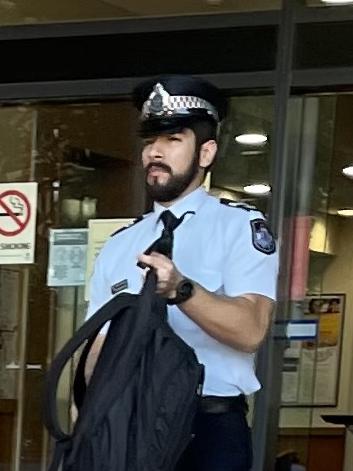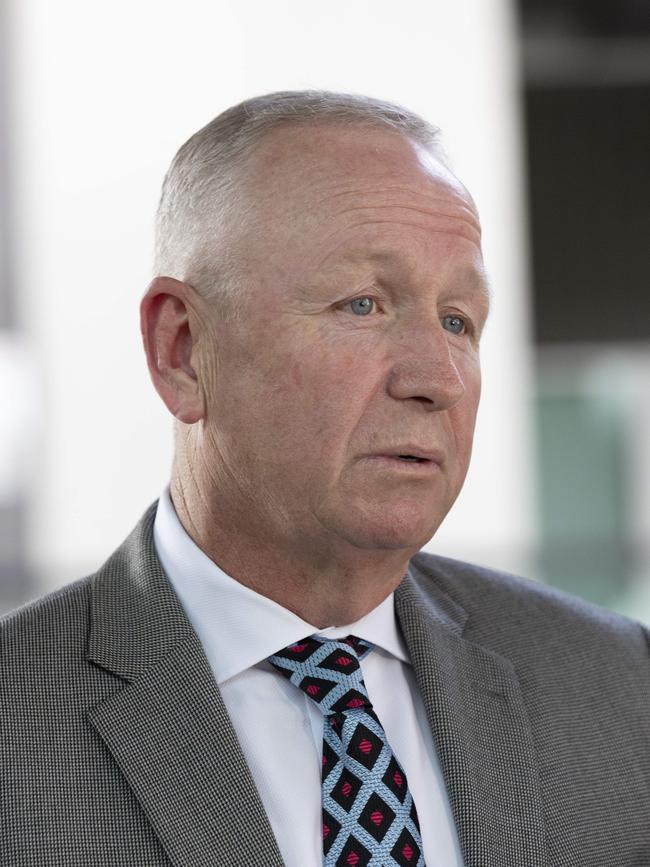Rockhampton watchhouse death in custody inquest hears from Dr Stephen Rashford
Queensland’s most qualified emergency medical respondant says there were medical symptoms which should have raised flags for police officers handling a man who died in the back of a Rockhampton police vehicle pod.
Police & Courts
Don't miss out on the headlines from Police & Courts. Followed categories will be added to My News.
Queensland’s most qualified emergency medical respondant says there were medical symptoms which should have raised flags for police officers handling a man who died in the back of a police vehicle pod.
These flags were outlined during an inquest into the death in custody of a man arrested in the carpark of Rockhampton’s Leichhardt Hotel in November 2019 and transported to the Rockhampton Watchhouse across the road in a ‘pod’ or ‘paddywagon’ where he was declared dead.
Queensland Ambulance Service medical director Dr Stephen Rashford, who has been in the position for 17 years and practising medicine for 30 years, gave evidence at the inquest.
The deceased man, who was aged in his mid 40s at the time, cannot be named for legal reasons and is referred to as ‘Adam’ in this article.
Dr Rashford went over what happened the night Adam died, based on his observations of body worn footage and medical reports provided to him.
He gave medical explanations for Adam’s symptoms and behaviours throughout the ordeal – from his change in behaviour once seated in the pod the first time, to when the doctor believes Adam lost all consciousness.
The footage, shown to the court, showed Adam’s demeanour changed once he realised how small the pod was compared to his size, described by Dr Rashford as ‘obese’. He was also more than 193 centimetres tall.
Dr Rashford told the court he “imagined” Adam suffered from claustrophobia – a phobia which is consistent and persistent where the person has an intense fear of confined places.
The footage showed Adam tried to remove himself from the space sparking his fear, only to be confronted by four Queensland Police officers who had escorted him to the pod for transport.
The court heard a ground struggle between Adam and the officers, who were backed up by two more officers who ran across the road from the police station after hearing a radio call for help, went on for five to seven minutes.
Senior Constable Dale Lally said before the ground struggle, the defendant had kicked or kneed him in the chest, which caused him immediate pain and pushed him backwards a little bit.
Constable Jade Traynor, who has been in the police force almost seven years, told the court: “this is still the worst (ground struggle) I’ve encountered” in relation to duration and “how hard it was to get control”.
The ground struggle was described by Dr Rashford as a “significantly exhausting” struggle between the man and the police officers.

He said tensing against police, against restraints, would cause a build up of acidosis at this point.
Dr Rashford said acidosis altered a person’s cardiac threshold.
Footage showed snippets of the struggle, with many body parts obscuring the vision, while repeated shouts of “help me” and “murder”, along with “you aren’t real cops” can be heard coming from Adam.
Dr Rashford said this was an indicator that Adam had “some form of distorted reality”.
“It does indicate his ability to understand exactly what was going on,” he said.
“The thing for me is you’ve got a fellow whose completely … significantly resisting attempted restraint … after a number of utterances of “I’m f---ed. I can’t breath”.
“And then he gets to a point where he is basically not uttering coherent words at all.
“And his physical evidence is not there anymore. He is not resisting anything.”
Dr Rashford referred to this as ‘100 mile an hour to zero syndrome’, seen in people about to have cardiac arrest caused by multiple factors.
“And that required further analysis of the person’s condition,” he said.
The court heard one of the four officers involved in the struggle called for urgent backup over the radio with at least two officers from the police station coming to their aid – one was Senior Constable Renzo Martinez and the other a first year constable tasked to the front counter for the night.

The court heard the first year constable testify she knelt on the defendant’s calves to stop him kicking.
Senior Constable Martinez said when he arrived, the man was on the ground, facedown.
He said he asked the other officers what he could do to help and Constable Lally said something about “head control”.
Footage from a body worn camera was played in court which clearly showed Senior Constable Martinez’s knee very quickly being placed near the man’s neck and shoulder.
The court heard the man grabbed at least two officer’s holsters, which contained their guns and or tasers, during the struggle and one could be heard saying “he’s grabbing at stuff”, in the body worn footage.
The court heard the group of officers gained control of the man and assisted him to sit up.
“The police were glad the physical efforts were over, but a person who resists significantly doesn’t just stop,” Dr Rashford said.
He said this was the most dangerous point of this situation.
“Because anyone who had physical exertion would take 40 minutes to recover,” Dr Rashford said.
The footage showed that after Adam was restrained, the officers then assisted Adam to his feet and walked him to the pod.
Ethical Standards Command commander Detective Sergeant Neil Parker, who led the internal investigation into what happened that night, told the inquest he believed that once Adam had stopped resisting on the ground, that would have been an opportunity to stop and assess him.
However, the man dropped to his knees after a few steps.
“He was acting like someone incredibly fatigued,” Dr Rashford said
“He is not making any significant progress or movement whatsoever.
“And that to me, these are just triggers that you need to try and understand: Has something happened to this individual? Has a medical event occurred? Why their condition changes?”
Detective Sergeant Parker agreed the leg weight drop incident was “another signal, another opportunity” where the officers could have paused and reassessed Adam.
However, he also believed the officers exhibited “the appropriate standard of care in line with their duties on the evening”.
Detective Sergeant Parker added that further training would have assisted in the officers identifying some potential signs of a medical episode, plus cameras installed in the pod providing better observations during transportation would have helped.
The court heard the officers helped Adam back up again and walked him to the pod.
Ms Pietzner-Hagan said at some point around this part of the incident, an audible bang could be heard on the recordings, followed by people laughing.
The court heard Dr Rashford wrote in his report that he observed Adam “collapsing forward and hitting the rear of the vehicle”, which was when the audible bang could be heard.

“My interpretation is that he did not have control of his movements,” he told the court.
“At that point, I think he, at best, was incredibly fatigued and at worst, within the process of becoming unconscious.”
Dr Rashford said he believed Adam slipped into complete unconsciousness, and near cardiac arrest, simultaneously as the police officers were pushing him back into the pod.
He explained his reasoning for that involved the fact the officers had to push his feet out of the doorway after shouting at Adam to move his feet and sit up on the seat, which he did not respond to verbally or physically, and grunting breathing as an indication of struggling to breath/ not a normal breathing style post significant physical exertion, plus “already hypostasis on his skin of his abdomen and face” which was seen in a lot of people who went into cardiac arrest.
“I think he needed a period of observation before being placed in the paddy wagon,” he said.
Despite the autopsy saying Adam had meth in his system at the time of death, Dr Rashford said his behaviours were not indicative of drug intoxication as he was mostly coherent to start with, then there was some gibberish and maybe paranoia.
The findings of the inquest are yet to be released.




